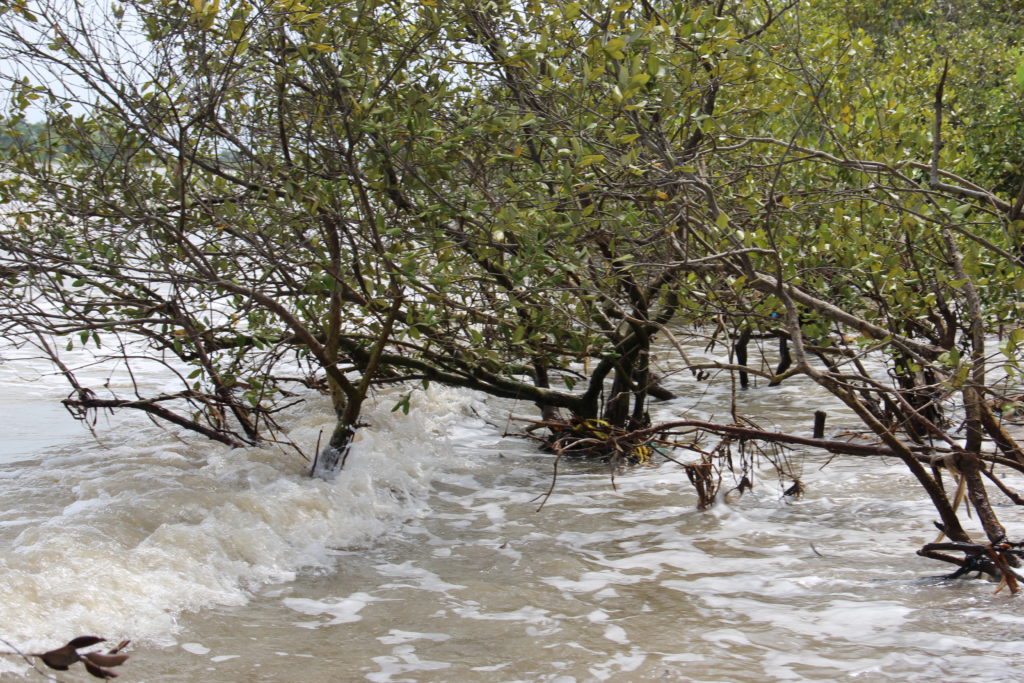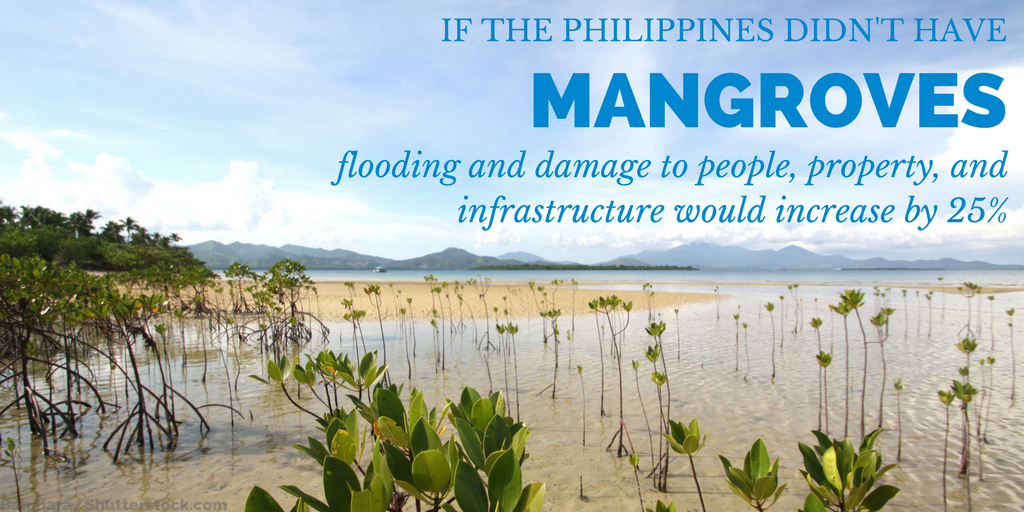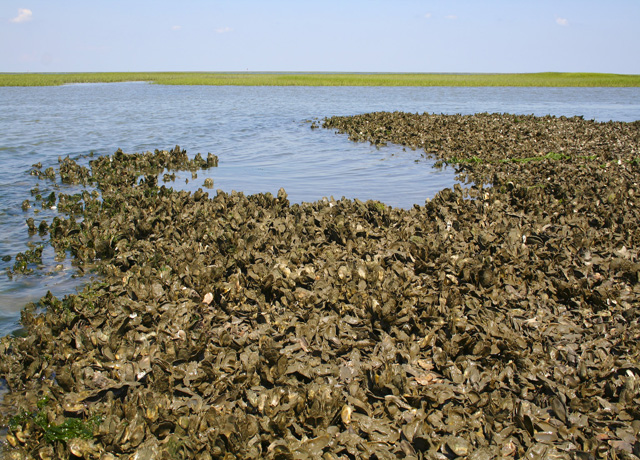Climate change poses a serious threat to coastlines, bringing rising sea levels, warming waters, and changing storm patterns. Coral reefs, mangroves, oyster reefs, and salt marshes can help reduce the risk of coastal hazards to coastal communities

Coastal protection from natural coastlines
- Coral reefs reduce wave energy by up to 97 percent.
- In the Philippines, Mexico, and Malaysia, the annual expected coastal protection benefits of reefs exceed $450 million per year, per country
- A 100-meter-wide belt of mangroves can reduce wave heights between 13 and 66 percent, and up to 100 percent where mangroves reach 500 meters or more in width.
- Saltmarshes can attenuate as much as 50% of smaller waves even by a barrier of just 10 meters
Our Projects
Flood risk benefits of coastal wetlands
In partnership with Delft University and in the applied research institute, Deltares, ground-breaking new models have been generated, mapping the value of coastal wetlands reducing storm surge flooding on a global scale. The work used a 2-dimensional modelling approach based on thousands of flood model simulations, with unprecedented spatial accuracy of 100m. The results are an improvement over previous 1-D models, which are likely to have considerable overestimated the benefits of wetlands on flood reduction. Nonetheless, by providing a more realistic estimate of benefits they get us closer to understanding this critical ecosystem service, in protecting both people and infrastructure.
The model includes multiple scenarios, but for the 1 in 100 year storm it shows that wetlands reduce flood depths in coastal wetland regions worldwide by 31%, and the overall extent of flooding by 10%. The value of such processes includes an overall 3% reduction in damage to infrastructure, saving $230 million per year world-wide, and the protection of 93,000 people per year from coastal flooding.

The maps also show us where these benefits are of particular importance. Mangrove nations including Indonesia, Colombia, Bangladesh and Tanzania are among the major beneficiaries. Tidal marshes or saltmarshes, being lower and simpler structures, are less powerful in reducing surge, but nonetheless they remain important, and in countries such as the United States, and the United Kingdom, they provide critical benefits.
Future scenarios from the model looked at the role coastal wetlands might play in a future world. Using a high emissions scenario (RCP8.5) for 2100 sea levels the model considers two possible visions – one assumes wetlands remain in place, binding sediments and keeping up with the rising waters; the other keeps the wetlands at the same elevation, such that many become submerged and lost. The results from this future-casting suggest that, where they can keep pace the benefits will remain broadly comparable as they are today. If there is no change in wetland elevation over this time-frame, almost all of these benefits will be lost.
The report from the study can be found here, and maps will be added to MOW in early 2026.
Coral Reefs’ Coastal Defense Value

A simple global model at relatively high resolution (500m) which assesses the role of coral reefs in reducing erosion and inundation. World-wide some 26% of the coastlines of the coral reef nations of the world receive some protection from the presence of nearby coral reefs. Many of these coasts are home to human populations and valuable assets. This model takes a long-term view, considering the likely impacts over 10-year timeframes, as impacts are typically driven by irregular extreme storm events. It estimates that, globally, some 5.3 million people and US$109 billion equivalent of GDP are protected by coral reefs. The results of this work are presented both at the shoreline where the benefits are “felt” and also projected out to highlight the role of particular reefs in generating these benefits. In both cases there are three measures – the number of people receiving protection; the likely economic benefit in terms of GDP-PPP (Purchasing Power Parity) protected in US dollars; and the likely protection to infrastructure, as modelled by the relative protection to night-time lights (NTL), which closely mirror human population and GDP, but also include other areas of high value (industry, transport hubs, low volume but high value tourism) which may not be captured in the other metrics
Flood Protection Benefits of Coral Reefs
To further assess the benefits of coral reef protection, TNC has worked with collaborators at the Institute of Environmental Hydraulics at the University of Cantabria (IH Cantabria) and UC Santa Cruz to combine ecological, engineering and economic approaches to value the benefits of reefs for flood reduction to people and property. View interactive map
Using high resolution modelling of flood hazards and damages, we have estimated the expected benefit of coral reefs for storm flood reduction. Building on recommended approaches, we looked at the potential damage costs from four different storm return periods (one-in-10 year, one-in-25, -50, and -100-year storms). In each case, we compare flooding for scenarios with reefs at their present height with scenarios for a loss of one meter in reef height. We estimate the land, population and built capital ($) flooded across all coral reef coastlines to a 90 meter resolution (Figure 1). We examined flooding in cross-shore profiles every two kilometers for all coral reefs globally and summarized these in coastal units of 10 profiles, giving our summary coastal segments of approximately 20-kilometer stretches, across >71,000 kilometers of coastline with coral reefs. For each coastal segment, we then derive the expected benefit of coral reefs for flood damage reduction from local to global levels in social and economic terms.
What we found is that reefs provide significant flood protection savings for people and property with some of their most important flood protection benefits from the most frequent storms. Just small declines in the height
of the reef crest allow much more wave energy to pass through to flood coastlines. For one-in-10-year events, storm costs would more than triple if we lost just one meter in the height of reefs. Reefs provide significant benefits even for higher intensity, 100-year events where damages would increase to $219 billion if we do not manage reefs well.

The countries with the most to gain in annual benefits from reef conservation and restoration include Indonesia, Philippines, Malaysia and Mexico. For each of these countries, the annual expected benefits of reefs exceed $450 million per year. And this benefit is only from the topmost meter of reefs and for direct flood reduction to built capital. Reefs provide many other benefits and the effects of flood protection on people are widely felt across countries and economies. The countries that may see the greatest annual benefits relative to their GDP include many Small Island Developing States particularly across the Caribbean.
Mangrove Coastal Protection: Guidance for Coastal Managers and Policy Makers

The Mapping Ocean Wealth team undertook detailed reviews of all the existing research into the role of mangroves in coastal protection. The resulting publication describes how a 100-meter-wide belt of mangroves can reduce wave heights between 13 and 66 percent, and up to 100 percent where mangroves reach 500 meters or more in width. If mangrove forests are sufficiently large, they can reduce storm surge peak water levels between 4 and 48 centimeters per kilometer of mangrove. In low-lying areas, even such relatively small reductions in peak water levels can reduce flooding, and prevent property damage.
Mangrove Coastal Protection in the Philippines

The Nature Conservancy, in partnership with the World Bank, The Philippines government, and the Environmental Hydraulics Institute IHCantabria, recently completed a study that quantifies the risk reduction benefits from mangroves in the Philippines.Using high-resolution flooding models, the Technical Report examines the flooding that would occur with and without mangroves under different storm conditions throughout the Philippines, and estimates the annual expected benefits of mangroves for protecting people and property in social and economic terms.
The Report, and its accompanying Policy Brief, provide a social and economic valuation of the flood protection benefits from mangroves in the Philippines. The work aims to support decisions across development, aid, risk reduction and conservation sectors as they seek to identify sustainable and cost-effective approaches for risk reduction. View the map associated with this project here.
Other MOW-linked studies look at the costs of natural versus engineered sea defenses and show that restoring mangroves can be two- to five-times cheaper than building a concrete breakwater to provide the same degree of protection.
Living Breakwaters

In Mobile Bay, Alabama, large-scale efforts are now underway to construct living breakwaters along shorelines facing rapid erosion. Through the American Recovery and Reinvestment Act (ARRA), federal “stimulus funding” has been used to construct more than two kilometers of submerged breakwaters, which are designed to support the rapid settlement of oysters and so gradually morph into living reefs.
Design is a key element—the reefs must serve a function: protecting adjacent marshes and seagrass beds from their prior state of rapid erosion, and so also defending roads and valuable coastal property. One of the important criteria for this project was the creation of jobs—short-term employment during the design and construction phase, but more beside that. Economists have found other returns on the investment in the fisheries sector. Recent research shows that for every new hectare of oyster reef created in Mobile Bay, we can expect an additional 3,200 adult blue crabs every year.
Additional Information
Ecosystems
Top image: ©Ethan Daniels. . Photo Credits in Text: © Jonathan Kerr, © Marjo Aho, © Mark Spalding, © Daniel White. Tiles (left to right): © Jeff Yonover, © Tim Calver, © Donna Squire, © Clay Bolt







